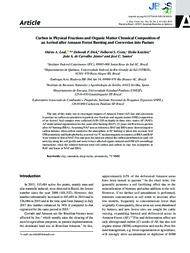Carbon in physical fractions and organic matter chemical composition of an acrisol after amazon forest burning and conversion into pasture.
Carbon in physical fractions and organic matter chemical composition of an acrisol after amazon forest burning and conversion into pasture.
Author(s): LEAL, O. A.; DICK, D. P.; COSTA, F. de S.; KNICKER, H.; CARVALHO JÚNIOR, J. A. de; SANTOS, J. C.
Summary: The aim of this study was to investigate impacts of Amazon Forest (AF) fire and conversion to pasture on carbon accumulation in particle size fractions and organic matter (OM) composition of an Acrisol. Soil samples were collected (0.00-2.00 m depth) in three sites: native AF (NAF); AF under natural regeneration for two years after burning (BAF); 23-years old Brachiaria pasture after AF burning (BRA). Assuming NAF area as reference, BAF and BRA areas showed negative carbon balance when carbon emitted to the atmosphere at AF burning is taken into account. Soil OM aromaticity and hydrophobicity, assessed via 13C nuclear magnetic resonance, in BRA and BAF were similar to that in NAF. Fire and post-fire land use altered the carbon distribution in sand, silt and clay along the soil profile and seem to have affected organo-mineral and OM self-assemblage interactions, since the relation between total soil carbon and carbon in clay was asymptotic in BAF and linear in NAF and BRA.
Publication year: 2019
Types of publication: Journal article
Unit: Embrapa Acre
Keywords: Acre, Acrisoles, Acrisols, Amazonia Occidental, Amazônia Ocidental, Argissolos, Bosque tropical húmedo, Burnt soils, Carbon sinks, Carbono, Cruzeiro do Sul (AC), Environmental impact, Estoque, Fazenda Santa Luzia, Floresta Tropical, Fogo, Impacto Ambiental, Materia orgánica del suelo, Matéria Orgânica, Natural regeneration, Regeneración natural, Regeneração Natural, Reservorios de carbono, Saturação, Soil organic matter, Suelos quemados, Tropical rain forests, Western Amazon
Observation
Some of Embrapa's publications are published as ePub files. To read them, use or download one of the following free software options to your computer or mobile device. Android: Google Play Books; IOS: iBooks; Windows and Linux: Calibre.
Access other publications
Access the Agricultural Research Database (BDPA) to consult Embrapa's full library collection and records.
Visit Embrapa Bookstore to purchase books and other publications sold by Embrapa.

